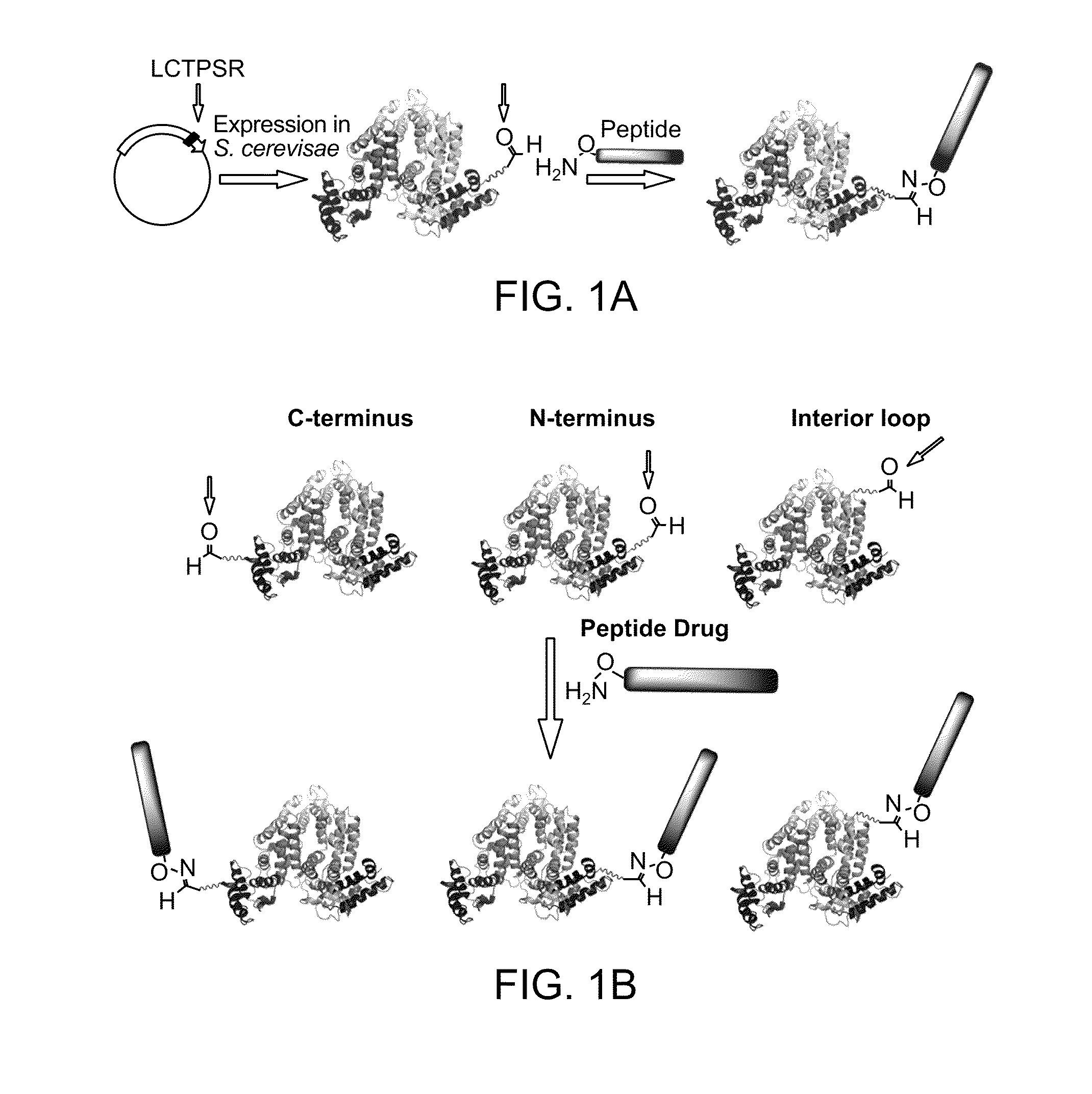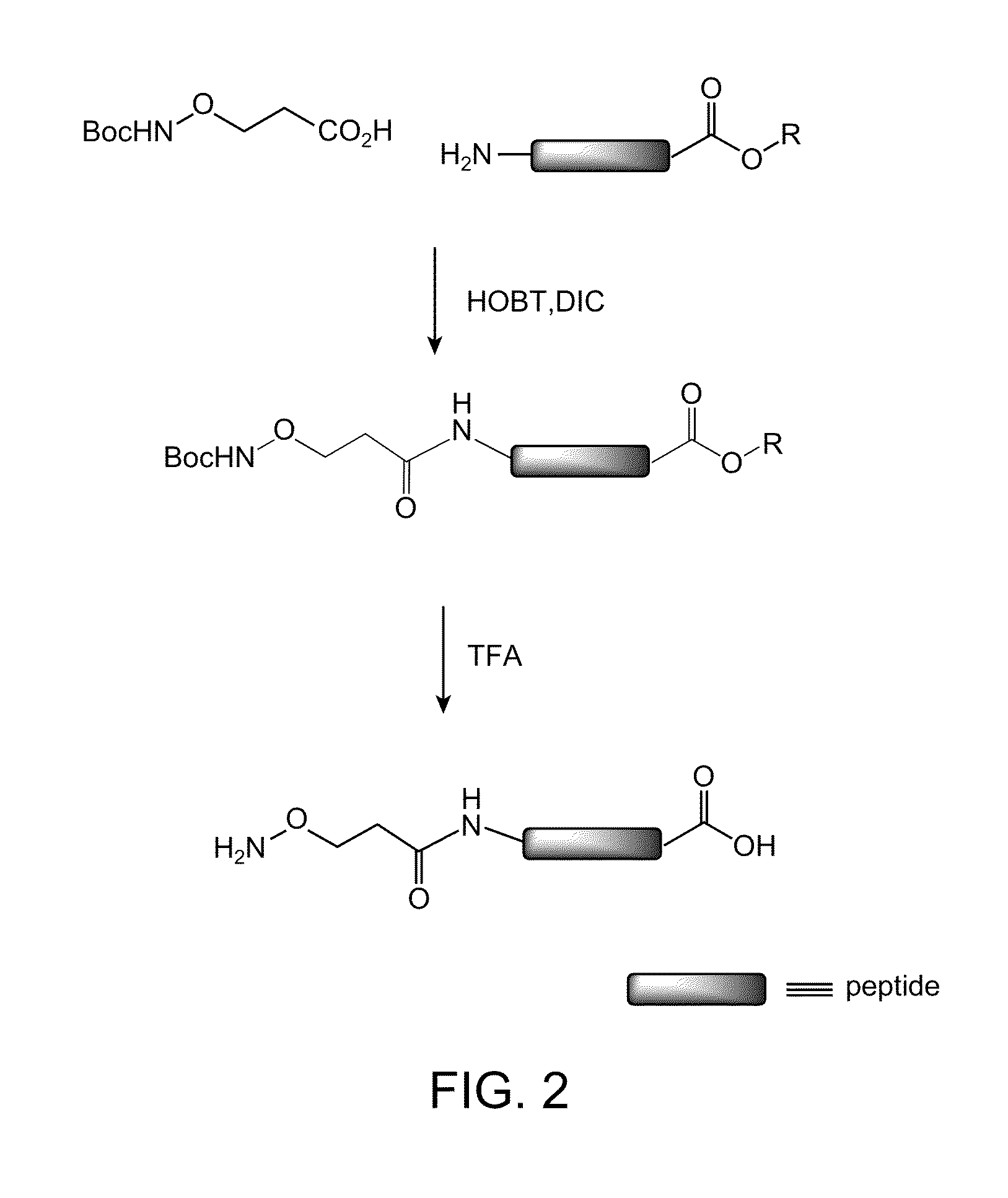Aldehyde-Tagged Protein-Based Drug Carriers and Methods of Use
a protein and drug carrier technology, applied in the field of protein and small molecule therapeutics, can solve the problems of heterogeneous mixture of conjugates and difficult control of the amount given to a patien
- Summary
- Abstract
- Description
- Claims
- Application Information
AI Technical Summary
Benefits of technology
Problems solved by technology
Method used
Image
Examples
example 1
Production of Panel of HSA Carrier Proteins
[0202]The ald-tag technology is used to provide for high-efficiency modification of secreted carrier proteins in mammalian cell culture system. An FGE and sulfatase motifs are used to install aldehyde tags in a recombinant human serum albumin (rHSA) in a yeast expression system, e.g., Saccharomyces cerevisiae. The FGly-containing ald tag will be exploited to conjugate drugs (e.g., small molecule drugs) to the HSA carrier protein. HSA is trafficked through the secretory pathway, similar to native sulfatases and the previously studied secreted Fc proteins, and are therefore will be readily be recognized as substrates by ER-resident FGE when expressed in mammalian cells. When expressed in yeast, the recombinant HSA containing the aldehyde tag motif is purified and reacted with purified recombinant FGE to convert the cysteine to formylglycine ex vivo, the addition of purified FGE to a purified recombinant protein to give the enzymatic transform...
example 2
Production of Carrier Proteins Having Multiple Ald Tags
[0206]Carrier proteins conjugated with multiple peptide drugs or small molecules can greatly enhance the efficacy of the biotherapeutic of interest. Thus multiple aldehyde tags will be installed into a single HSA carrier protein. An HSA carrier protein having Ald6 tags (LCTPSR, (SEQ ID NO:1)) placed in different locations along the peptide backbone of the carrier protein will be generated.
[0207]Three different Ald6 tag sequences were appended to the recombinant HSA carrier protein. These constructs, containing Ald6 sequences, are shown in FIG. 6 (depicting three uniquely tagged proteins). The constructs were expressed in S. cerevisae, purified and reacted along with purified M. tuberculosis FGE. Reaction conditions were optimized to maximize the conversion of the cysteine to FGly. The converted protein was purified and analyzed for the presence of FGly by reaction with aminooxy-biotin or aminooxy FLAG peptide followed by Western...
example 3
Conjugation of Peptides to the Protein Scaffold
[0209]Short serum half-life has been a challenge in the development peptide therapeutics. Peptides are typically cleared from the bloodstream within minutes to hours after administration, and thus may not be sufficiently exposed in the target tissue for a desired clinical effect. Aldehyde tagged carrier proteins, such as ald tagged HSA can be used as a carrier protein to increase the serum half-life of the peptides.
[0210]Two carrier protein-drug conjugates are generated—one a conjugate with Calcitonin and one a conjugate with GLP-1. As mentioned previously, by coupling the peptides to the HSA carrier protein the absorption and elimination half-lives will be increased.
[0211]The peptides were synthesized via standard Fmoc-based solid phase peptide synthesis protocols. The final residue added at the N terminus was (t-Boc-aminooxy)acetic acid followed by cleavage under standard conditions. Deprotection to expose the amino-oxy functionality ...
PUM
| Property | Measurement | Unit |
|---|---|---|
| Flexibility | aaaaa | aaaaa |
Abstract
Description
Claims
Application Information
 Login to View More
Login to View More - R&D
- Intellectual Property
- Life Sciences
- Materials
- Tech Scout
- Unparalleled Data Quality
- Higher Quality Content
- 60% Fewer Hallucinations
Browse by: Latest US Patents, China's latest patents, Technical Efficacy Thesaurus, Application Domain, Technology Topic, Popular Technical Reports.
© 2025 PatSnap. All rights reserved.Legal|Privacy policy|Modern Slavery Act Transparency Statement|Sitemap|About US| Contact US: help@patsnap.com



